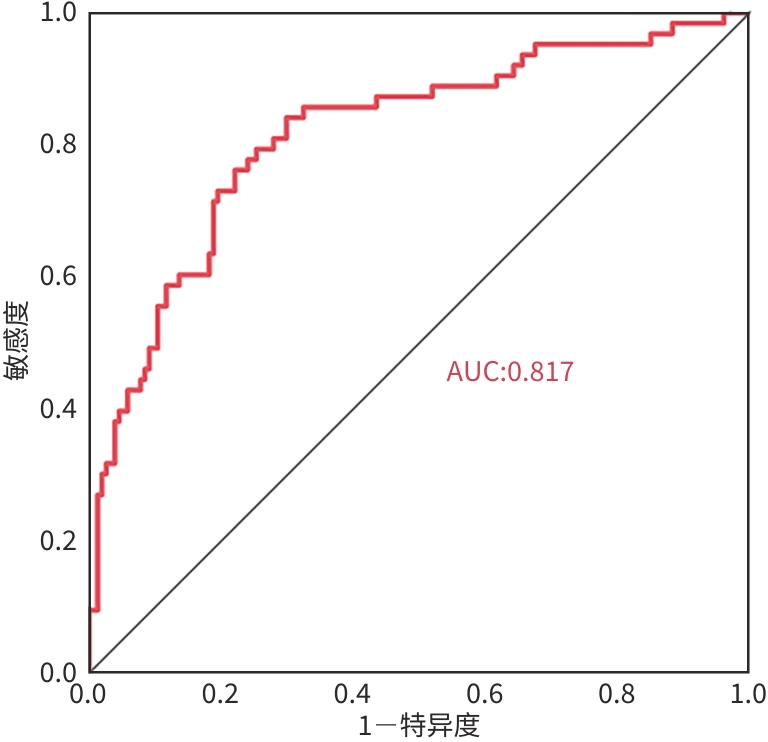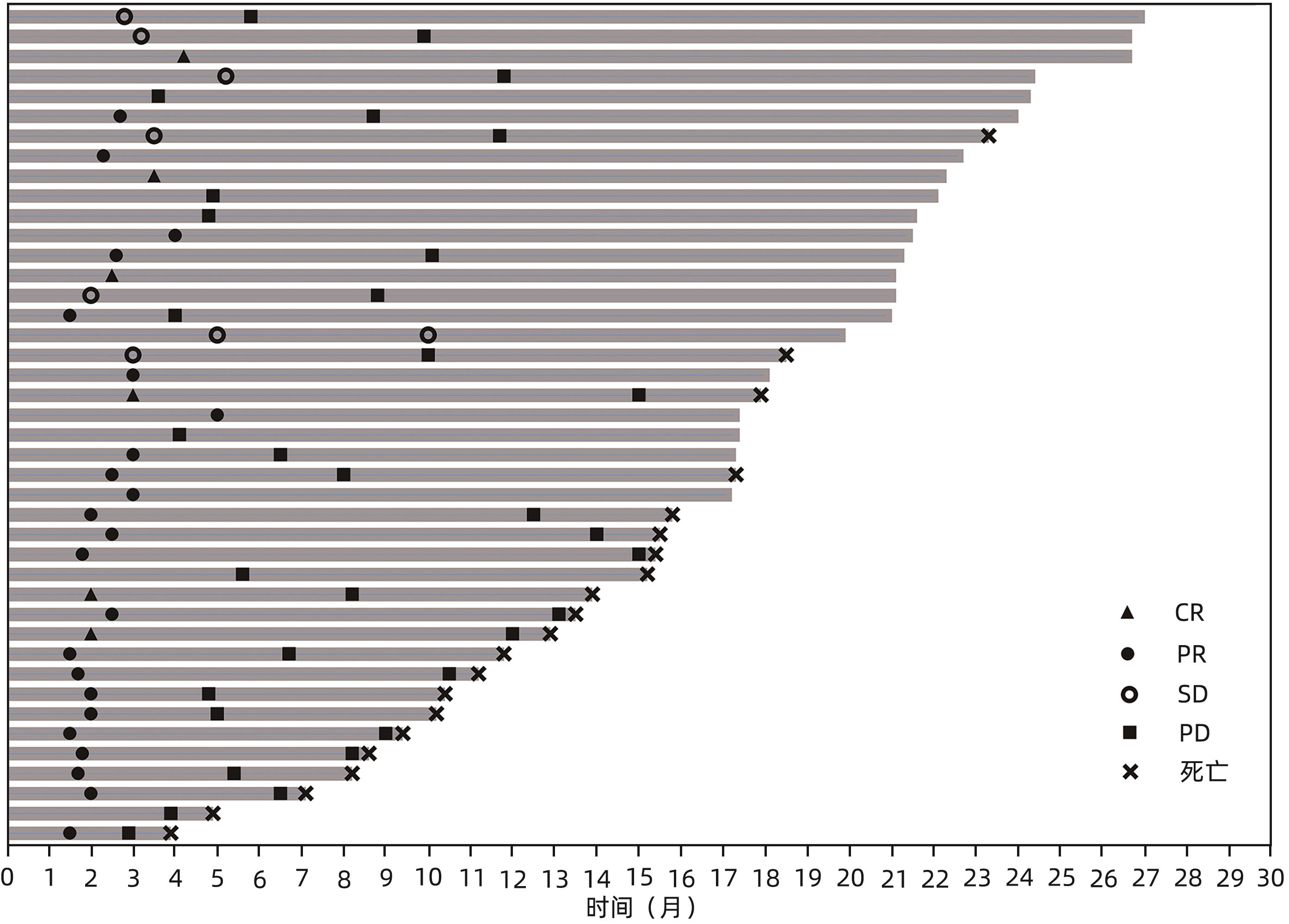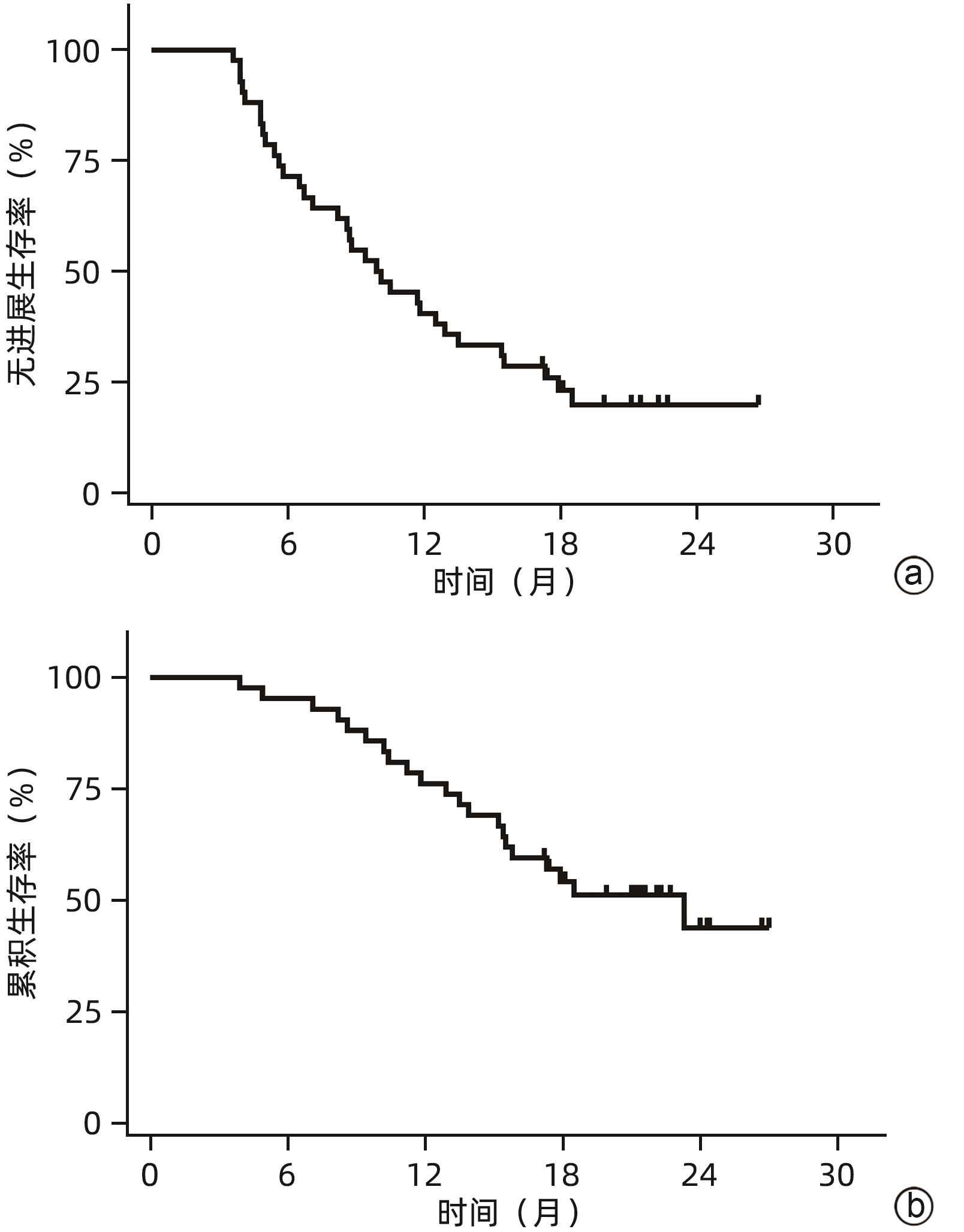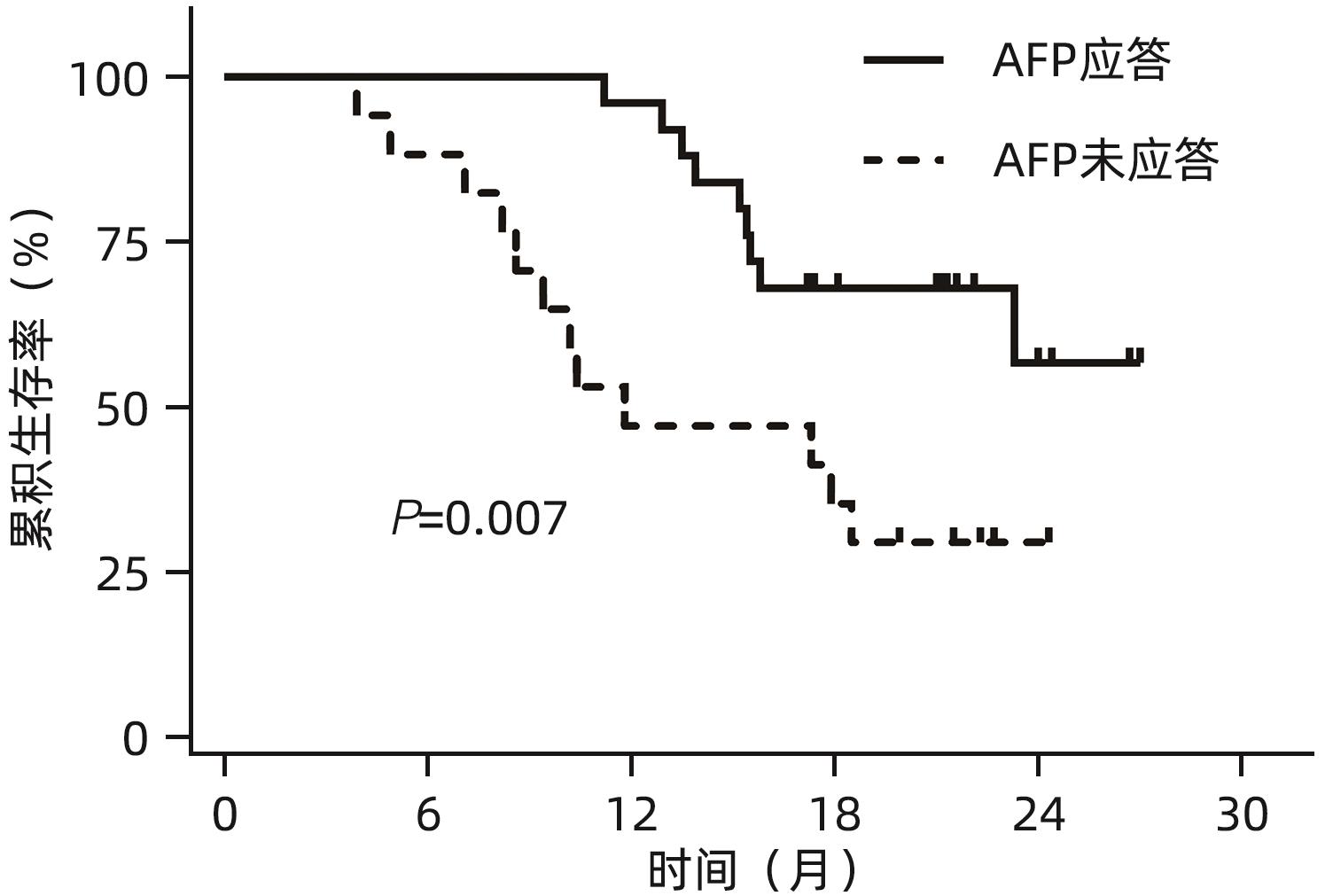丙型肝炎肝硬化失代偿患者再代偿的影响因素分析
DOI: 10.12449/JCH250212
Influencing factors for recompensation in patients with decompensated hepatitis C cirrhosis
-
摘要:
目的 研究丙型肝炎肝硬化失代偿期患者再代偿发生的影响因素,建立预测模型。 方法 选取2019年1月—2022年12月在昆明市第三人民医院住院诊断为丙型肝炎肝硬化失代偿的患者217例,至少1年之内再住院无门静脉高压相关并发症即再代偿组(n=63),未再代偿者为对照组(n=154)。收集相关临床资料,对可能影响再代偿发生的因素进行单因素及多因素分析。计量资料符合正态分布的两组间比较采用成组t检验,不符合正态分布的两组间比较采用Mann-Whitney U检验。计数资料两组间比较采用χ²检验或Fisher’s确切概率法。运用二元Logistic回归模型分析丙型肝炎肝硬化失代偿患者再代偿发生的影响因素,采用受试者操作特征曲线(ROC曲线)评价模型的预测效能。 结果 217例丙型肝炎肝硬化失代偿期患者中63例发生再代偿(29.03%)。再代偿组与对照组相比,HIV史(χ²=4.566,P=0.034)、部分脾栓塞史(χ²=6.687,P=0.014)、Child-Pugh 评分(χ²=11.978,P=0.003)、腹水分级(χ²=14.229,P<0.001)、Alb(t=4.063,P<0.001)、前白蛋白(Z=-3.077,P=0.002)、HDL(t=2.854,P=0.011)、超敏C反应蛋白(Z=-2.447,P=0.014)、凝血酶原时间(Z=-2.441,P=0.015)、CEA(Z=-2.113,P=0.035)、AFP(Z=-2.063,P=0.039)、CA125(Z=-2.270,P=0.023)、三碘甲状腺素原氨酸(Z=-3.304,P<0.001)、甲状腺素(Z=-2.221,P=0.026)、CD45+(Z=-2.278,P=0.023)、IL-5(Z=-2.845,P=0.004)、TNF-α(Z=-2.176,P=0.030)、门静脉宽度(Z=-5.283,P=0.005)差异均有统计学意义。多因素分析结果显示,部分脾栓塞史(OR=3.064,P=0.049)、HIV史(OR=0.195,P=0.027)、少量腹水(OR=3.390,P=0.017)、AFP(OR=1.003,P=0.004)及门静脉宽度(OR=0.600,P<0.001)为丙型肝炎肝硬化失代偿期发生再代偿的独立影响因素。ROC曲线结果显示HIV史、腹水分级、部分脾脏栓塞史、AFP、门静脉宽度、联合预测模型的曲线下面积依次为0.556、0.641、0.560、0.589、0.745、0.817。 结论 部分脾栓塞史、少量腹水及AFP水平升高的丙型肝炎肝硬化失代偿期患者更容易出现再代偿,有HIV史、门静脉宽度增加的患者不易出现再代偿。 Abstract:Objective To investigate the influencing factors for recompensation in patients with decompensated hepatitis C cirrhosis, and to establish a predictive model. Methods A total of 217 patients who were diagnosed with decompensated hepatitis C cirrhosis and were admitted to The Third People’s Hospital of Kunming l from January, 2019 to December, 2022 were enrolled, among whom 63 patients who were readmitted within at least 1 year and had no portal hypertension-related complications were enrolled as recompensation group, and 154 patients without recompensation were enrolled as control group. Related clinical data were collected, and univariate and multivariate analyses were performed for the factors that may affect the occurrence of recompensation. The independent-samples t test was used for comparison of normally distributed measurement data between two groups, and the Mann-Whitney U test was used for comparison of non-normally distributed measurement data between two groups; the chi-square test or the Fisher’s exact test was used for comparison of categorical data between two groups. A binary Logistic regression analysis was used to investigate the influencing factors for recompensation in patients with decompensated hepatitis C cirrhosis, and the receiver operating characteristic (ROC) curve was used to assess the predictive performance of the model. Results Among the 217 patients with decompensated hepatitis C cirrhosis, 63 (29.03%) had recompensation. There were significant differences between the recompensation group and the control group in HIV history (χ2=4.566, P=0.034), history of partial splenic embolism (χ2=6.687, P=0.014), Child-Pugh classification (χ2=11.978, P=0.003), grade of ascites (χ2=14.229, P<0.001), albumin (t=4.063, P<0.001), prealbumin (Z=-3.077, P=0.002), high-density lipoprotein (t=2.854, P=0.011), high-sensitivity C-reactive protein (Z=-2.447, P=0.014), prothrombin time (Z=-2.441, P=0.015), carcinoembryonic antigen (Z=-2.113, P=0.035), alpha-fetoprotein (AFP) (Z=-2.063, P=0.039), CA125 (Z=-2.270, P=0.023), TT3 (Z=-3.304, P<0.001), TT4 (Z=-2.221, P=0.026), CD45+ (Z=-2.278, P=0.023), interleukin-5 (Z=-2.845, P=0.004), tumor necrosis factor-α (Z=-2.176, P=0.030), and portal vein width (Z=-5.283, P=0.005). The multivariate analysis showed that history of partial splenic embolism (odds ratio [OR]=3.064, P=0.049), HIV history (OR=0.195, P=0.027), a small amount of ascites (OR=3.390, P=0.017), AFP (OR=1.003, P=0.004), and portal vein width (OR=0.600, P<0.001) were independent influencing factors for the occurrence of recompensation in patients with decompensated hepatitis C cirrhosis. The ROC curve analysis showed that HIV history, grade of ascites, history of partial splenic embolism, AFP, portal vein width, and the combined predictive model of these indices had an area under the ROC curve of 0.556, 0.641, 0.560, 0.589, 0.745, and 0.817, respectively. Conclusion For patients with decompensated hepatitis C cirrhosis, those with a history of partial splenic embolism, a small amount of ascites, and an increase in AFP level are more likely to experience recompensation, while those with a history of HIV and an increase in portal vein width are less likely to experience recompensation. -
Key words:
- Hepatitis C /
- Liver Cirrhosis /
- Recompensatory /
- Risk Factors
-
大多数肝癌患者起病隐匿,诊断时已为晚期,失去根治性治疗机会,预后较差[1]。在全球Ⅲ期临床试验IMbrave 150中,阿替利珠单抗联合贝伐珠单抗(T+A方案)在不可切除肝细胞癌患者的一线治疗中的总生存期(overall survival,OS)和无进展生存期(progression-free survival,PFS)优于索拉非尼[2]。同样,在中国进行的多中心研究ORIENT-32表明,在不可切除的原发性肝癌患者中,信迪利单抗联合贝伐珠单抗类似物(双达方案)作为一线治疗的OS和PFS也显著优于索拉非尼[3]。基于上述研究,免疫检查点抑制剂联合抗血管生成治疗已成为不可切除肝癌的一线治疗标准,但客观缓解率仅有30%左右,远期生存率也有待提高[4-5]。
局部治疗对于控制病灶及改善长期生存均有较好疗效,目前立体定向放疗(stereotactic body radiotherapy,SBRT)已成为肝癌局部治疗的有效手段之一,与靶免方案的联合治疗也取得较好效果[6-7]。从机制上来看,放疗不仅可以造成肿瘤细胞DNA的直接损伤,还能导致肿瘤抗原释放,激活机体主动免疫,从而增强肿瘤免疫治疗效果[8]。抗血管生成治疗可以使肿瘤血管系统正常化,改善肿瘤微环境,从而提高放疗效果[9]。因此,SBRT联合双达方案的三联治疗从理论上可以改善不可切除肝癌患者的预后,但相关治疗效果、不良反应以及疗效预测指标鲜有报道。
本研究回顾性分析接受SBRT联合双达方案治疗的不可切除肝癌患者资料,评估预后及不良反应,探索预后预测指标,为该方案的治疗管理提供参考。
1. 资料和方法
1.1 研究对象
纳入2022年3月—12月在本中心放射治疗科接受SBRT联合双达方案治疗的不可切除肝癌患者42例。纳入标准:(1)经病理组织学确诊或符合临床诊断标准的原发性肝癌患者;(2)巴塞罗那分期为B或C期;(3)ECOG评分为0或1分;(4)治疗前基线AFP>40 mAU/mL;(5)根据改良实体瘤评价标准,至少有1处肝内可测量病灶。排除标准:(1)既往进行过抗肿瘤治疗;(2)双达方案治疗小于2个周期;(3)合并其他恶性肿瘤;(4)治疗后影像学或实验室数据缺失。
1.2 治疗方案
1.2.1 SBRT
本科室采用SBRT设备射波刀(美国Accuracy公司的VSI Cyberknife)。所有患者治疗前在CT引导下植入金标3~5枚,5~7天后于CT模拟机(somatom40排CT,德国Siemens公司)下行放疗定位。以CT模拟机平扫影像为基准图像,MR(Philips Ingenia MR-RT 3.0T,瑞士Royal Dutch Philips Electronics Ltd公司)增强影像为辅助图像,定位完成后将图像传至TPS系统(MultiPlan4.0系统,美国Accuracy公司)。放疗专科医生勾画相应肿瘤靶区和危及器官。大体肿瘤靶区基础上外扩3~5 mm为计划靶区,根据正常器官限量制定治疗计划,参照《AAPM TG101报告》[10]。SBRT剂量及分割模式主要取决于肝功能和正常器官剂量限制,也与病灶的大小、数量和位置等有关。给予处方剂量为36~50 Gy,分5~6次,连续照射。
1.2.2 双达方案
患者在完成放疗1周后接受信迪利单抗联合贝伐珠单抗治疗,具体剂量为:信迪利单抗200 mg,静脉滴注,每3周1次;贝伐珠单抗10 mg/kg,静脉滴注,每3周1次。双达方案一直使用到出现疾病进展或无法耐受的严重不良反应。
1.3 随访和评估
首次随访时间为治疗后6~8周,此后每6~8周随访1次。随访时检查血常规、肝功能、凝血功能、血清肿瘤标志物、上腹部增强CT或磁共振成像以及肺部CT,以评估肿瘤缓解。必要时进行PET-CT检查以确认是否肝外转移。主要终点为OS[定义为从SBRT开始日期至全因死亡日期或末次随访日期(2024年5月30日)的时间]以及PFS[定义为从SBRT开始日期至首次检测到影像学进展或全因死亡日期的时间]。次要终点为客观缓解率(objective response rate,ORR)和疾病控制率(disease control rate,DCR),根据mRECIST标准将肿瘤缓解分为完全缓解(complete remission,CR)、部分缓解(partial response,PR)、疾病稳定(stable disease,SD)和疾病进展(progressive disease,PD),并由2名经验丰富的放射科医生独立评价。ORR定义为获得CR+PR患者的百分比,DCR定义为获得CR+PR+SD患者的百分比。AFP应答定义为治疗后6~8周AFP下降大于50%。根据不良事件通用术语标准5.0版评估不良事件。
1.4 统计学方法
所有数据的统计分析使用SPSS 26.0或Graphpad Prism进行。通过Kaplan-Meier法和Log-rank检验估计生存率并进行比较;使用Cox比例风险模型估计HR和95%CI,在单变量模型中P<0.1的变量纳入多变量分析。P<0.05为差异有统计学意义。
2. 结果
2.1 一般资料
42例接受SBRT联合双达方案治疗的晚期肝癌患者中男39例,占比92.8%。>50岁的患者31例(73.8%),既往存在HBV感染41例(97.6%),肿瘤病灶最大径>5 cm有28例(66.6%),存在门静脉癌栓(portal vein tumor thrombus,PVTT)36例(85.8%),发生肝外转移8例(19.1%),提示入组患者肿瘤负荷相对较重。入组患者治疗前AFP均升高,中位值为626.5 ng/mL(表1)。42例患者均为初治,既往未行抗肿瘤治疗,此次接受SBRT剂量中位值为45 Gy,具体放疗剂量分割方案如下:36 Gy/6 Fx的患者有2例(4.7%),48 Gy/6 Fx有8例(19%),40 Gy/5 Fx有2例(4.7%),45 Gy/5 Fx有23例(54.7%),50 Gy/5 Fx有7例(16.6%)。
表 1 42例患者基线临床资料Table 1. The characteristics of 42 patients指标 数值 年龄[例(%)] ≤50岁 11(26.2) >50岁 31(73.8) 性别[例(%)] 男 39(92.8) 女 3(7.2) 慢性肝疾病[例(%)] 乙型肝炎 41(97.6) 其他 1(2.4) PVTT[例(%)] 有 36(85.8) 无 6(14.2) 肿瘤最大径[例(%)] ≤5 cm 14(33.4) >5 cm 28(66.6) 肝外转移[例(%)] 有 8(19.1) 无 34(80.9) ECOG评分[例(%)] 0分 35(83.3) 1分 7(16.7) Child-Pugh分级[例(%)] A级 26(61.9) B级 16(38.1) ALBI分级[例(%)] 1级 8(19.1) 2级 34(80.9) BCLC分期[例(%)] B期 1(2.3) C期 41(97.7) AFP(ng/mL) 626.5(83.1~4 105.0) 放疗剂量(Gy) 45(45~48) 2.2 肿瘤控制及远期生存情况
随访至2024年5月30日,共有21例患者死亡,其中8例因肝衰竭死亡,7例因肿瘤进展死亡,4例因继发感染死亡,2例因消化道出血死亡。在肿瘤局部控制方面,治疗后6例患者(14.3%)达到CR,23例患者(54.7%)达到PR,7例患者(16.7%)为SD,6例患者(14.3%)为PD,全组患者ORR为69%,DCR为85.7%(图1)。中位随访时间为21.6个月(95%CI:20.4~22.8),中位PFS为10.0个月(95%CI:6.7~13.0)(图2a),中位OS为23.3个月(95%CI:14.7~31.8)(图2b)。
2.3 影响预后的因素
影响患者预后的单因素分析见表2,治疗后6~8周出现AFP应答的患者有25例,多因素分析结果显示AFP应答与患者良好的预后相关(HR=0.31,95%CI:0.13~0.75,P=0.009);AFP应答组中位OS显著优于AFP未应答组(未达到 vs 11.8个月,P=0.007)(图3)。
表 2 影响OS的单因素分析Table 2. Univariate analysis for factors affecting OS临床特征 HR(95%CI) P值 年龄(≤50岁/>50岁) 0.33(0.10~1.13) 0.077 性别(女/男) 0.74(0.10~5.50) 0.764 门静脉侵犯(无/有) 0.24(0.03~1.79) 0.163 肿瘤大小(≤5 cm/>5 cm) 1.25(0.52~3.01) 0.617 肝外转移(有/无) 1.03(0.35~3.08) 0.953 Child-Pugh分级(A级/B级) 0.53(0.22~1.24) 0.144 ALBI分级(1级/2级) 0.88(0.30~2.62) 0.818 AFP应答(是/否) 0.32(0.14~0.78) 0.011 门静脉侵犯(无/有) 1.11(0.61~2.03) 0.725 用药周期 0.96(0.91~1.01) 0.086 放疗剂量(Gy) 0.99(0.88~1.12) 0.912 ECOG评分(1分/0分) 0.75(0.25~2.26) 0.614 2.4 不良反应
42例患者均未发生非预期不良反应或治疗相关死亡,不良反应多为1~2级,其中血液系统不良反应较常见,发生白细胞减少10例(23.8%),血小板减少8例(19.0%),1例患者出现3级血小板减少,给予重组人血小板生成素后血小板恢复正常水平。10例患者(23.8%)出现转氨酶升高,给予保肝药物对症治疗,未进一步恶化。10例患者出现低蛋白血症,放疗结束1月内可缓解。3例患者出现免疫相关性甲状腺功能减退,4例患者发生免疫相关性皮疹,均为1~2级,未使用激素及免疫抑制剂等药物干预,持续时间4~10天,未影响后续治疗(表3)。
表 3 治疗相关不良反应Table 3. Treatment-related adverse events不良反应 所有级别[例(%)] 3~4级[例(%)] 白细胞减少 10(23.8) 0(0.0) 血小板减少 8(19.0) 1(2.4) 高血压 2(4.8) 0(0.0) 恶心呕吐 3(7.1) 0(0.0) 消化道出血 1(2.4) 0(0.0) 蛋白尿 3(7.1) 0(0.0) 腹水 9(21.4) 1(2.4) 转氨酶升高 10(23.8) 0(0.0) 肾功能不全 1(2.4) 0(0.0) 高胆红素 4(9.5) 0(0.0) 低蛋白血症 10(23.8) 1(2.4) 免疫相关性甲状腺功能减退 3(7.1) 0(0.0) 免疫相关性皮疹 4(9.5) 0(0.0) 3. 讨论
在目前的临床诊疗中,免疫联合抗血管生成治疗已成为晚期肝细胞癌的一线标准方案,但ORR仅有30%左右,亟待提高[11-12]。随着放疗技术的进展,放疗不仅可导致肿瘤细胞DNA双链断裂,还能诱导免疫原性细胞死亡,刺激全身抗肿瘤免疫[13]。抗血管生成治疗可通过使肿瘤血管正常化,形成免疫友好的肿瘤微环境来增强放疗的功效[9]。此外,免疫治疗可以克服放疗导致肿瘤表面PD-L1表达增加、抑制性免疫细胞功能增强等负面作用,从而增强放疗的协同效率[14]。这为放疗联合免疫及抗血管生成治疗提供了坚实的理论依据。
既往回顾性研究分析了放疗联合靶免的治疗方案,Su等[15]研究发现,PD-1抑制剂与抗血管药物联合调强放疗的ORR为42.6%,Wang等[6]报道的SBRT联合仑伐替尼和PD-1抑制剂的ORR可达到63%。一项前瞻性多中心Ⅱ期临床研究显示,放疗联合双达方案的ORR为58.7%,中位PFS为13.8个月,中位OS为24.0个月[16]。与上述前瞻性研究不同,本研究放疗在双达方案之前,患者ORR为69%,与单独双达方案以及上述前瞻性研究相比均有提升,中位OS与前瞻性研究结果相当。在双达方案之前进行SBRT或许具有协同效应,可获得较好的局部缓解及生存结局,本研究为该三联疗法的可行性和安全性提供了临床证据。
本研究入组患者中有36例(85.8%)存在PVTT,通常与不良预后相关[17]。但由于PVTT细胞对辐射的敏感性较高,SBRT已被证明在控制PVTT方面疗效显著[18]。一方面,放疗使癌栓收缩有助于恢复部分门静脉血流,可改善肝功能;另一方面,PVTT的控制能消除部分侵入血流的肿瘤细胞,进而减少了血行转移,产生较好的肿瘤反应和生存结局[19]。除此之外,在双达方案之前使用SBRT可以有效降低肝脏肿瘤负荷,改善肝功能,提高患者对后续治疗的耐受性,从而接受更多周期的双达方案维持治疗,这可能是本组患者预后良好的原因之一。
在预后指标的探索方面,AFP是一种与肿瘤负荷和生物学行为相关的生物标志物,数十年来在肝癌领域发挥着重要作用[20]。当前指南推荐AFP与超声联合,用于肝癌高危人群的早期筛查[21]。此外,AFP易于在随访期间重复检测,可评估其动态变化来监测治疗效果[22]。目前关于AFP应答的临界值尚无定论,国内外研究多为主观定义。一项Meta分析显示,AFP应答的定义为AFP水平下降20%或50%所占比例居多,且该研究提示与AFP水平下降50%的临界值相比,AFP水平下降20%对OS和PFS的预测效果更好,但倾向于仅接受靶向治疗的患者[23]。Shao等[24]将早期AFP应答定义为治疗后4周下降超过20%,这与晚期肝癌免疫治疗较好的预后有关。另一项研究表明在接受T+A方案治疗的晚期肝癌患者中,治疗第6周时AFP较基线降低≥75%或升高≤10%的患者均具有较长的PFS及OS[25]。本研究参考入组患者AFP水平下降比例的中位值,将SBRT联合双达治疗后6~8周AFP水平下降>50%定义为AFP应答,多因素分析提示AFP应答是患者OS的独立影响因素。AFP应答可辅助影像学评估,有助于更好地识别该三联疗法中疗效显著的患者,并对疗效不佳患者及时调整治疗方案。但是,对于不同AFP初始值的肝癌患者,AFP应答的预测价值是否一致仍未知,且关于判断AFP应答的最佳时间窗目前亦无定论。在未来的探索中,需要更多高质量的前瞻性研究对AFP给予更多关注。
本研究也证实了SBRT联合双达方案治疗的安全性,双达方案治疗最常见的不良反应为蛋白尿、血小板减少、转氨酶升高、高血压和甲状腺功能减退等[3],与本研究不良反应相似,治疗期间未发生导致停药或死亡的不良事件。本研究中所采用的射波刀特有的呼吸追踪系统有效降低了照射过程中肝脏位移带来的肝损伤。另一方面以肿瘤为中心,剂量梯度衰减也使得周围组织所受照射剂量更低。总之,不良反应主要集中在1~2级,SBRT与双达方案联合产生协同毒性的可能性较小。
综上所述,SBRT联合双达方案治疗晚期肝癌可改善生存且安全性可控,治疗后6~8周AFP水平下降>50%与预后良好相关。但本研究为回顾性研究,样本量相对较少,未来仍需开展前瞻性的随机、对照、多中心临床研究,进一步验证结论。
-
表 1 再代偿组与对照组一般资料比较
Table 1. Baseline characteristics between recompensation group and control group
项目 再代偿组(n=63) 对照组(n=154) 统计值 P值 男性[例(%)] 33(52.4) 102(66.2) χ²=3.650 0.065 年龄(岁) 50(43~56) 49(44~55) Z=-0.654 0.513 BMI(kg/m²) 22.22(21.11~24.46) 23.01(21.42~25.04) Z=-1.084 0.278 吸烟史[例(%)] 38(60.3) 105(68.2) χ²=1.230 0.274 糖尿病史[例(%)] 12(19.0) 26(16.9) χ²=0.145 0.844 高血压史[例(%)] 8(12.7) 19(12.3) χ²=0.005 >0.05 HIV史[例(%)] 4(6.3) 27(17.5) χ²=4.566 0.034 口服NSBB[例(%)] 9(14.3) 12(7.8) χ²=2.157 0.204 TIPS史[例(%)] 3(4.8) 3(1.9) χ²=0.360 0.236 内镜治疗史[例(%)] 12(19.0) 17(11.0) χ²=2.477 0.116 部分脾栓塞史[例(%)] 12(19.0) 11(7.1) χ²=6.687 0.014 饮酒史[例(%)] 31(49.2) 91(59.1) χ²=1.775 0.228 基因分型[例(%)] χ²=2.969 0.397 1 5(7.9) 11(7.1) 2 3(4.8) 7(4.5) 3 51(81.0) 133(86.4) 6 4(6.3) 3(1.9) Child-Pugh分级[例(%)] χ²=11.978 0.003 A级 16(25.4) 13(8.4) B级 34(54.0) 91(59.1) C级 13(20.6) 50(32.5) 腹水分级[例(%)] χ²=14.229 <0.001 无 14(22.2) 19(12.3) 少量 27(42.9) 38(24.7) 中大量 22(34.9) 97(62.9) 感染[例(%)] 23(36.5) 57(37.0) χ²=0.005 >0.05 HE[例(%)] 2(3.2) 10(6.5) χ²=0.516 0.270 HCV RNA阳性[例(%)] 49(77.8) 113(73.4) χ²=0.458 0.499 表 2 再代偿组与对照组的实验室检查结果比较
Table 2. Comparison of laboratory test between recompensation group and control group
指标 再代偿组(n=63) 对照组(n=154) 统计值 P值 WBC(×109/L) 3.67(2.57~5.42) 3.79(2.75~5.28) Z=-0.363 0.716 Neu(×109/L) 1.91(1.38~4.00) 2.27(1.54~3.70) Z=-0.457 0.647 Hb(×109/L) 122.00(94.00~137.00) 115.50(86.75~134.00) Z=-1.336 0.181 PLT(×109/L) 64.00(46.00~93.00) 65.00(43.00~92.25) Z=-0.320 0.749 TBil(mmol/L) 30.80(20.20~43.10) 31.80(19.75~49.53) Z=-0.653 0.514 ALT(U/L) 54.00(37.00~117.00) 59.50(41.75~96.50) Z=-0.318 0.750 AST(U/L) 44.00(24.00~77.00) 40.00(25.00~66.00) Z=-0.442 0.659 TP(g/L) 63.71±10.41 62.21±10.23 t=0.978 0.329 Alb(g/L) 32.20±5.81 28.68±5.83 t=4.063 <0.001 PA(mg/L) 109.90(85.40~144.00) 89.90(71.83~121.43) Z=-3.077 0.002 GGT(U/L) 55.00(36.00~137.00) 66.00(36.00~145.75) Z=-0.194 0.846 TC(mmol/L) 2.94(2.42~3.60) 2.80(2.15~3.45) Z=-1.388 0.165 LDL(mmol/L) 1.73(1.17~2.21) 1.41(1.03~1.99) Z=-1.659 0.970 HDL(mmol/L) 0.93±0.34 0.85±0.36 t=2.854 0.011 Cr(μmol/L) 59.00(54.00~70.00) 60.00(50.00~79.25) Z=-0.488 0.625 hs-CRP(mg/L) 1.49(0.63~4.53) 3.17(0.91~9.78) Z=-2.447 0.014 IL-6(pg/mL) 17.34(10.18~31.47) 18.75(11.33~37.73) Z=-1.136 0.256 PCT(ng/mL) 0.11(0.09~0.15) 0.13(0.09~0.23) Z=-0.822 0.411 APTT(s) 41.18±7.46 41.42±7.13 t=-0.214 0.829 PT(s) 15.90(14.70~17.90) 16.90(15.38~18.93) Z=-2.441 0.015 CEA(ng/mL) 2.98(1.79~4.73) 3.63(2.43~5.08) Z=-2.113 0.035 AFP(ng/mL) 9.33(4.77~18.86) 5.95(3.58~12.44) Z=-2.063 0.039 CA125(U/mL) 56.30(20.41~255.50) 160.13(31.77~324.55) Z=-2.270 0.023 CA19-9(U/mL) 25.28(11.00~41.38) 31.98(15.97~46.50) Z=-1.330 0.183 CA153(U/mL) 13.90(9.82~18.05) 15.37(11.33~20.91) Z=-1.601 0.109 PIVKA(mAU/mL) 23.40(18.00~36.00) 28.00(21.15~41.00) Z=-1.666 0.096 TT3(nmol/L) 1.76(1.42~2.06) 1.53(1.25~1.80) Z=-3.304 <0.001 TT4(nmol/L) 110.30(85.09~120.00) 92.70(76.85~111.52) Z=-2.221 0.026 TSH(μIU/mL) 2.41(1.75~3.60) 2.12(1.50~3.19) Z=-1.652 0.099 CD45+(个/μL) 1 032.06(756.63~1 297.77) 950.40(732.35~1 105.77) Z=-2.278 0.023 CD3+(个/μL) 767.60(523.15~967.34) 696.38(512.72~855.88) Z=-1.418 0.156 CD8+(个/μL) 218.05(150.78~353.83) 233.09(161.09~312.80) Z=-0.004 0.997 IL-1(pg/mL) 13.84(6.67~21.67) 12.19(5.15~19.66) Z=-1.366 0.172 IL-2(pg/mL) 3.24(2.69~4.58) 3.42(2.40~4.73) Z=-0.056 0.955 IL-4(pg/mL) 3.93±2.88 3.15±1.99 t=-1.949 0.055 IL-5(pg/mL) 2.84(2.03~3.67) 2.30(1.75~3.00) Z=-2.845 0.004 IFN-γ(pg/mL) 12.54(8.27~17.93) 10.75(6.63~17.13) Z=-1.098 0.272 IFN-α(pg/mL) 43.30(4.32~98.09) 18.71(4.10~90.87) Z=-1.580 0.114 TNF-α(pg/mL) 7.95(5.22~10.95) 6.43(4.36~9.08) Z=-2.176 0.030 表 3 再代偿组与对照组超声检查结果比较
Table 3. Comparison of ultrasound results between recompensation group and control group
指标 再代偿组(n=63) 对照组(n=154) 统计值 P值 门静脉宽度(mm) 12.00(10.00~13.20) 13.60(12.60~15.00) Z=-5.283 0.005 脾静脉宽度(mm) 9.00(6.00~10.00) 9.00(8.00~10.00) Z=-0.816 0.415 门静脉流速(cm/s) 14.21±3.36 13.73±2.76 t=-1.101 0.272 脾脏厚度(mm) 49.38±10.38 50.73±9.02 t=0.956 0.340 脾脏长度(mm) 138.80(124.00~153.00) 144.30(129.00~160.00) Z=-1.301 0.193 左肝长度(mm) 53.00(47.00~58.00) 54.00(50.00~58.55) Z=-1.362 0.173 右肝长度(mm) 109.00(96.00~119.00) 110.00(100.00~118.25) Z=0.051 0.959 表 4 多因素Logistic回归分析结果
Table 4. Results of multivariate Logistic regression analysis
项目 β值 SE Wald χ² OR 95%CI P值 HIV史 -1.634 0.737 4.918 0.195 0.046~0.827 0.027 少量腹水 1.221 0.509 5.746 3.390 1.249~9.199 0.017 部分脾栓塞史 1.120 0.569 3.867 3.064 1.004~9.350 0.049 AFP 0.003 0.001 8.182 1.003 1.001~1.006 0.004 门静脉宽度 -0.511 0.112 20.688 0.600 0.481~0.748 <0.001 注:HIV史赋值:是=1,否=0;部分脾脏栓塞史赋值:是=1,否=0;腹水赋值:中大量腹水=0,无腹水=1,少量腹水=2。
表 5 单个及联合预测因子的预测价值
Table 5. Predictive value of individual and combined predictors
项目 AUC 95%CI 敏感度 特异度 截断值 HIV史 0.556 0.475~0.637 0.175 0.937 腹水分级 0.641 0.560~0.723 0.630 0.651 部分脾栓塞史 0.560 0.472~0.647 0.929 0.190 AFP 0.589 0.503~0.676 0.556 0.649 8.79 门静脉宽度 0.745 0.671~0820 0.779 0.635 12.2 联合预测模型 0.817 0.751~0.882 0.841 0.701 -
[1] World Health Organization. Global progress report on HIV, viral hepatitis and sexually transmitted infections, 2021. Accountability for the global health sector strategies 2016-2021: actions for impact[M]. Geneva: World Health Organization, 2021. [2] COLLABORATORS POH. Global change in hepatitis C virus prevalence and cascade of care between 2015 and 2020: A modelling study[J]. Lancet Gastroenterol Hepatol, 2022, 7( 5): 396- 415. DOI: 10.1016/S2468-1253(21)00472-6. [3] JALAN R, D’AMICO G, TREBICKA J, et al. New clinical and pathophysiological perspectives defining the trajectory of cirrhosis[J]. J Hepatol, 2021, 75( Suppl 1): S14- S26. DOI: 10.1016/j.jhep.2021.01.018. [4] YEO YH, HE XY, LV F, et al. Trends of cirrhosis-related mortality in the USA during the COVID-19 pandemic[J]. J Clin Transl Hepatol, 2023, 11( 3): 751- 756. DOI: 10.14218/JCTH.2022.00313. [5] CRAIG AJ, von FELDEN J, GARCIA-LEZANA T, et al. Tumour evolution in hepatocellular carcinoma[J]. Nat Rev Gastroenterol Hepatol, 2020, 17( 3): 139- 152. DOI: 10.1038/s41575-019-0229-4. [6] Chinese Society of Hepatology, Chinese Medical Association. Guidelines on the management of ascites and complications in cirrhosis[J]. J Clin Hepatol, 2017, 33( 10): 1847- 1863. DOI: 10.3969/j.issn.1001-5256.2017.10.003.中华医学会肝病学分会. 肝硬化腹水及相关并发症的诊疗指南[J]. 临床肝胆病杂志, 2017, 33( 10): 1847- 1863. DOI: 10.3969/j.issn.1001-5256.2017.10.003. [7] de FRANCHIS R, BOSCH J, GARCIA-TSAO G, et al. Baveno VII-Renewing consensus in portal hypertension[J]. J Hepatol, 2022, 76( 4): 959- 974. DOI: 10.1016/j.jhep.2021.12.022. [8] Hepatology Branch of Chinese Medical Association. Guidelines on the management of ascites in cirrhosis(2023 version)[J]. Chin J Hepatol, 2023, 31( 8): 813- 826. DOI: 10.3760/cma.j.cn501113-20230719-00011.中华医学会肝病学分会. 肝硬化腹水诊疗指南(2023年版)[J]. 中华肝脏病杂志, 2023, 31( 8): 813- 826. DOI: 10.3760/cma.j.cn501113-20230719-00011. [9] KIM TH, UM SH, LEE YS, et al. Determinants of re-compensation in patients with hepatitis B virus-related decompensated cirrhosis starting antiviral therapy[J]. Aliment Pharmacol Ther, 2022, 55( 1): 83- 96. DOI: 10.1111/apt.16658. [10] JANG JW, CHOI JY, KIM YS, et al. Long-term effect of antiviral therapy on disease course after decompensation in patients with hepatitis B virus-related cirrhosis[J]. Hepatology, 2015, 61( 6): 1809- 1820. DOI: 10.1002/hep.27723. [11] Chinese Society of Hepatology and Chinese Society of Infectious Diseases, Chinese Medical Association. Guideline for the prevention and treatment of hepatitis C(2022 version)[J]. Chin J Clin Infect Dis, 2022, 15( 6): 428- 447. DOI: 10.3760/cma.j.issn.1674-2397.2022.06.002.中华医学会肝病学分会, 中华医学会感染病学分会. 丙型肝炎防治指南(2022年版)[J]. 中华临床感染病杂志, 2022, 15( 6): 428- 447. DOl: 10.3760/cma.j.issn.1674-2397.2022.06.002. DOI: 10.3760/cma.j.issn.1674-2397.2022.06.002 [12] Chinese Society of Hepatology, Chinese Society of Gastroenterology, Chinese Society of Digestive Endoscopology of Chinese Medical Association. Guidelines on the management of esophagogastric variceal bleeding in cirrhotic portal hypertension[J]. J Clin Hepatol, 2023, 9( 3): 527- 538. DOI: 10.3760/cmaj.cn501113-20220824-00436.中华医学会肝病学分会, 中华医学会消化病学分会, 中华医学会消化内镜学分会. 肝硬化门静脉高压食管胃静脉曲张出血的防治指南[J]. 临床肝胆病杂志, 2023, 39( 3): 527- 538. DOI: 10.3760/cmaj.cn501113-20220824-00436. [13] General Office of National Health Commission. Standard for diagnosis and treatment of primary liver cancer(2022 edition)[J]. J Clin Hepatol, 2022, 38( 2): 288- 303. DOI: 10.3969/j.issn.1001-5256.2022.02.009.国家卫生健康委办公厅. 原发性肝癌诊疗指南(2022年版)[J]. 临床肝胆病杂志, 2022, 38( 2): 288- 303. DOl: 10.3969/j.issn.1001-5256.2022.02.009. DOI: 10.3969/j.issn.1001-5256.2022.02.009 [14] WANG Q, ZHAO H, DENG Y, et al. Validation of Baveno VII criteria for recompensation in entecavir-treated patients with hepatitis B-related decompensated cirrhosis[J]. J Hepatol, 2022, 77( 6): 1564- 1572. DOI: 10.1016/j.jhep.2022.07.037. [15] ZHANG T, DENG Y, KANG HY, et al. Recompensation of complications in patients with hepatitis B virus-related decompensated cirrhosis treated with entecavir antiviral therapy[J]. Chin J Hepatol, 2023, 31( 7): 692- 697. DOI: 10.3760/cma.j.cn501113-20230324-00126.张婷, 邓优, 康海燕, 等. 恩替卡韦抗病毒治疗的乙型肝炎失代偿期肝硬化患者并发症的再代偿[J]. 中华肝脏病杂志, 2023, 31( 7): 692- 697. DOI: 10.3760/cma.j.cn501113-20230324-00126. [16] HOFER BS, SIMBRUNNER B, HARTL L, et al. Hepatic recompensation according to Baveno VII criteria is linked to a significant survival benefit in decompensated alcohol-related cirrhosis[J]. Liver Int, 2023, 43( 10): 2220- 2231. DOI: 10.1111/liv.15676. [17] HOFER BS, BURGHART L, HALILBASIC E, et al. Evaluation of potential hepatic recompensation criteria in patients with PBC and decompensated cirrhosis[J]. Aliment Pharmacol Ther, 2024, 59( 8): 962- 972. DOI: 10.1111/apt.17908. [18] BENMASSAOUD A, FREEMAN SC, ROCCARINA D, et al. Treatment for ascites in adults with decompensated liver cirrhosis: A network meta-analysis[J]. Cochrane Database Syst Rev, 2020, 1( 1): CD013123. DOI: 10.1002/14651858.CD013123.pub2. [19] European Association for the Study of the Liver. EASL Clinical Practice Guidelines for the management of patients with decompensated cirrhosis[J]. J Hepatol, 2018, 69( 2): 406- 460. DOI: 10.1016/j.jhep.2018.03.024. [20] RIPOLL C, GROSZMANN R, GARCIA-TSAO G, et al. Hepatic venous pressure gradient predicts clinical decompensation in patients with compensated cirrhosis[J]. Gastroenterology, 2007, 133( 2): 481- 488. DOI: 10.1053/j.gastro.2007.05.024. [21] CARACENI P, RIGGIO O, ANGELI P, et al. Long-term albumin administration in decompensated cirrhosis(ANSWER): An open-label randomised trial[J]. Lancet, 2018, 391( 10138): 2417- 2429. DOI: 10.1016/S0140-6736(18)30840-7. [22] POSE E, TORRENTS A, REVERTER E, et al. A notable proportion of liver transplant candidates with alcohol-related cirrhosis can be delisted because of clinical improvement[J]. J Hepatol, 2021, 75( 2): 275- 283. DOI: 10.1016/j.jhep.2021.02.033. [23] ARAVINTHAN AD, BARBAS AS, DOYLE AC, et al. Characteristics of liver transplant candidates delisted following recompensation and predictors of such delisting in alcohol-related liver disease: A case-control study[J]. Transpl Int, 2017, 30( 11): 1140- 1149. DOI: 10.1111/tri.13008. [24] GIARD JM, DODGE JL, TERRAULT NA. Superior wait-list outcomes in patients with alcohol-associated liver disease compared with other indications for liver transplantation[J]. Liver Transpl, 2019, 25( 9): 1310- 1320. DOI: 10.1002/lt.25485. [25] JACHS M, HARTL L, SCHAUFLER D, et al. Amelioration of systemic inflammation in advanced chronic liver disease upon beta-blocker therapy translates into improved clinical outcomes[J]. Gut, 2021, 70( 9): 1758- 1767. DOI: 10.1136/gutjnl-2020-322712. [26] REIBERGER T, FERLITSCH A, PAYER BA, et al. Non-selective betablocker therapy decreases intestinal permeability and serum levels of LBP and IL-6 in patients with cirrhosis[J]. J Hepatol, 2013, 58( 5): 911- 921. DOI: 10.1016/j.jhep.2012.12.011. [27] GLUUD LL, KRAG A. Banding ligation versus beta-blockers for primary prevention in oesophageal varices in adults[J]. Cochrane Database Syst Rev, 2012( 8): CD004544. DOI: 10.1002/14651858.CD004544.pub2. [28] HERNÁNDEZ-GEA V, ARACIL C, COLOMO A, et al. Development of ascites in compensated cirrhosis with severe portal hypertension treated with β-blockers[J]. Am J Gastroenterol, 2012, 107( 3): 418- 427. DOI: 10.1038/ajg.2011.456. [29] D’AMICO G, MORABITO A, D’AMICO M, et al. New concepts on the clinical course and stratification of compensated and decompensated cirrhosis[J]. Hepatol Int, 2018, 12( Suppl 1): 34- 43. DOI: 10.1007/s12072-017-9808-z. [30] XIE QY, GAO FW, LEI ZH, et al. Comparative study of non-selective and highly selective splenic artery embolization in patients with liver cirrhosis secondary to hypersplenism[J]. Chin J Hepatobiliary Surgery, 2021, 27( 12): 917- 922. DOI: 10.3760/cma.j.cn113884-20210527-00182.谢青云, 高峰畏, 雷泽华, 等. 脾动脉非选择性与高选择性插管后部分脾栓塞术在肝硬化继发脾功能亢进患者中的对比研究[J]. 中华肝胆外科杂志, 2021, 27( 12): 917- 922. DOI: 10.3760/cma.j.cn113884-20210527-00182. [31] LI ZW, WANG YQ, ZHANG YW. The mechanism of action of partial splenic artery embolization in treatment of liver cirrhosis and hypersplenism[J]. J Clin Hepatol, 2023, 39( 7): 1714- 1720. DOI: 10.3969/j.issn.1001-5256.2023.07.029.李宗伟, 汪桠琴, 张跃伟. 部分脾动脉栓塞治疗肝硬化脾功能亢进的作用机制[J]. 临床肝胆病杂志, 2023, 39( 7): 1714- 1720. DOI: 10.3969/j.issn.1001-5256.2023.07.029. [32] MADOFF DC, DENYS A, WALLACE MJ, et al. Splenic arterial interventions: Anatomy, indications, technical considerations, and potential complications[J]. Radiographics, 2005, 25( Suppl 1): S191- S211. DOI: 10.1148/rg.25si055504. [33] BAI L, LI QG. Effect of partial splenic embolization on inflammatory response and coagulation in patients with hypersplenism in liver cirrhosis[J]. Clin Res, 2023, 31( 8): 36- 38. DOI: 10.12385/j.issn.2096-1278(2023)08-0036-03.白露, 李庆刚. 部分脾栓塞术对肝硬化脾功能亢进患者炎症反应及凝血功能的影响[J]. 临床研究, 2023, 31( 8): 36- 38. DOI: 10.12385/j.issn.2096-1278(2023)08-0036-03. [34] PAVEL V, SCHARF G, MESTER P, et al. Partial splenic embolization as a rescue and emergency treatment for portal hypertension and gastroesophageal variceal hemorrhage[J]. BMC Gastroenterol, 2023, 23( 1): 180. DOI: 10.1186/s12876-023-02808-1. [35] ISHIKAWA T, SASAKI R, NISHIMURA T, et al. A novel therapeutic strategy for esophageal varices using endoscopic treatment combined with splenic artery embolization according to the Child-Pugh classification[J]. PLoS One, 2019, 14( 9): e0223153. DOI: 10.1371/journal.pone.0223153. [36] Committee on HIV/Liver Diseases, Chinese Association of STD and AIDS Prevention and Control; Guangzhou Eighth People’s Hospital, Guangzhou Medical University. Chinese expert consensus on the diagnosis and treatment of HIV co-infection with HBV and HCV[J]. J Clin Hepatol, 2024, 40( 6): 1107- 1113. DOI: 10.12449/JCH240607.中国性病艾滋病防治协会HIV合并肝病专业委员会, 广州医科大学附属市八医院. 中国HIV合并HBV、HCV感染诊治专家共识[J]. 临床肝胆病杂志, 2024, 40( 6): 1107- 1113. DOI: 10.12449/JCH240607. [37] van den EYNDE E, CRESPO M, ESTEBAN JI, et al. Response-guided therapy for chronic hepatitis C virus infection in patients coinfected with HIV: A pilot trial[J]. Clin Infect Dis, 2009, 48( 8): 1152- 1159. DOI: 10.1086/597470. [38] PINEDA JA, GARCÍA-GARCÍA JA, AGUILAR-GUISADO M, et al. Clinical progression of hepatitis C virus-related chronic liver disease in human immunodeficiency virus-infected patients undergoing highly active antiretroviral therapy[J]. Hepatology, 2007, 46( 3): 622- 630. DOI: 10.1002/hep.21757. [39] WEN J, ZHOU Y, WANG J, et al. Interactions between Th1 cells and Tregs affect regulation of hepatic fibrosis in biliary atresia through the IFN-γ/STAT1 pathway[J]. Cell Death Differ, 2017, 24( 6): 997- 1006. DOI: 10.1038/cdd.2017.31. [40] DAGUR RS, WANG WM, CHENG Y, et al. Human hepatocyte depletion in the presence of HIV-1 infection in dual reconstituted humanized mice[J]. Biol Open, 2018, 7( 2): bio029785. DOI: 10.1242/bio.029785. [41] ARIFIN KT, SULAIMAN S, SAAD SM, et al. Elevation oftumour markers TGF-β,M2-PK, OV-6 and AFP in hepatocellular carcinoma(HCC)-induced rats and their suppression bymicroalgae Chlorella vulgaris[J]. BMC Cancer, 2017, 17( 1): 879. DOI: 10.1186/s12885-017-3883-3. [42] MASETTI C, LIONETTI R, LUPO M, et al. Lack of reduction in serumalpha-fetoprotein during treatment with direct antiviral agents predicts hepatocellular carcinoma development in a large cohort of patients with hepatitis C virus-related cirrhosis[J]. J Viral Hepat, 2018, 25( 12): 1493- 1500. DOI: 10.1111/jvh.12982. [43] ZHAO P, ZHAI YF, ZHANG HH. Application of serum alpha fetoprotein and prothrombin time activity in predicting prognosis of patients with acute-on-chronic liver failure[J]. J Prac Hepat, 2017, 20( 2): 230- 231. DOI: 10.3969/j.issn.1672-5069.2017.02.027.赵萍, 翟玉峰, 张怀宏. 血清甲胎蛋白和凝血酶原活动度水平对慢加急性肝衰竭患者预后的预测价值研究[J]. 实用肝脏病杂志, 2017, 20( 2): 230- 231. DOI: 10.3969/j.issn.1672-5069.2017.02.027. [44] ZHANG AM, YOU SL, WAN ZH, et al. Relation of liver fibrosis indicators and prognosis in hepatitis B-related acute on chronic liver failure[J]. J Clin Hepatol, 2012, 28( 6): 459- 461. DOI: 10.3969/j.issn.1001-5256.2012.06.016.张爱民, 游绍莉, 万志红, 等. 乙型肝炎病毒相关慢加急性肝衰竭患者肝纤维化、肝功能、病毒学指标及甲胎蛋白水平与预后的关系[J]. 临床肝胆病杂志, 2012, 28( 6): 459- 461. DOI: 10.3969/j.issn.1001-5256.2012.06.016. -




 PDF下载 ( 1211 KB)
PDF下载 ( 1211 KB)

 下载:
下载:




 下载:
下载:






